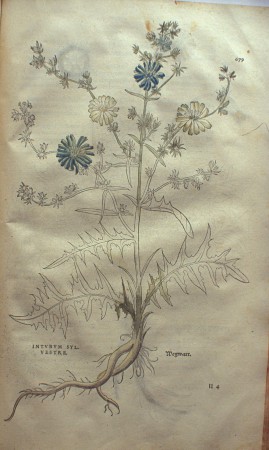While we’re on the subject of radicchio diversity, old Roman medicines and the like, we were pleased to be sent a link to Renaissance Herbals, a collaboration between the Smithsonian Institution and the Biblioteca Nazionale Centrale di Roma. There are some lovely images to peruse and use, like this one, of wild chicory, Cichorium intybus.:

One could complain, of course, that the links between the illustrations and other sorts of information are non-existent. But hey, you can’t have everything.
Ecxellent your effort to investigate that herbs.
Greece is widely known for plants biodiversity with herbal plants possessing a great part in that issue.
In particular, there are small islands with isolated aromatic /medicinal plants populations known from ancient time for their therapheutical /antioxidant uses. I have to notice that Hippocrates, the Father of Medicine (460-377 B.C.) lived in Kos island characterized for herbal vegetation.
That species still occured in high populations, while others are needed to be conserved due to their extinction.
I am deeply interested in a permanent cooperation as in my laboratory we run research work on medicinal plants and agrobiodiversity generally.
We will keep touch
My best regards
Garifalia Economou
Assistant Professor
Laboratory of Agronomy
Faculty of Crop Production Science
Agricultural University of Athens
I take the liberty to write you just to inform you that the website PLANT is still in progress, therefore not complete. Your complaint about the lack of information on the plants illustrated is only partially correct; once the website will be completed there will be a lot of metadata, such as scientific names, common names and vernacular names of the plants; codicological information of the editions selected, information on the authors and on the publishers, links to botanical plates from the US National Herbarium, photos of the plant in nature, and all this will be retrievable by name of the plant, title of the herbal, etc. And, it will be possible to retrieve the images of one plant in chronological order, so as to see the evolution of the botanical illustration. It is true ‘you can’t have everything’, but hopefully soon you will have it!
Thanks and best,
Emanuela Appetiti
co-PI of the PLANT Project